
Rhadinophis prasinum – BLYTH, 1854
(Elaphe prasina / Gonyosoma prasinum)
(Elaphe prasina / Gonyosoma prasinum)
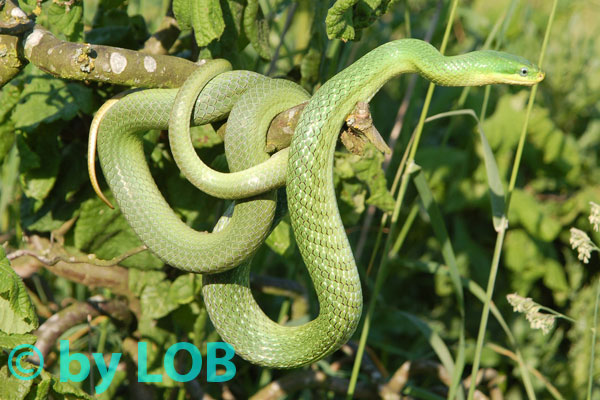
Rhadinophis prasinum: Even though quite secretive this species also likes to climb • Obwohl normalerweise versteckt lebend, klettert diese Art auch gerne.
© Lutz Obelgönner
© Lutz Obelgönner
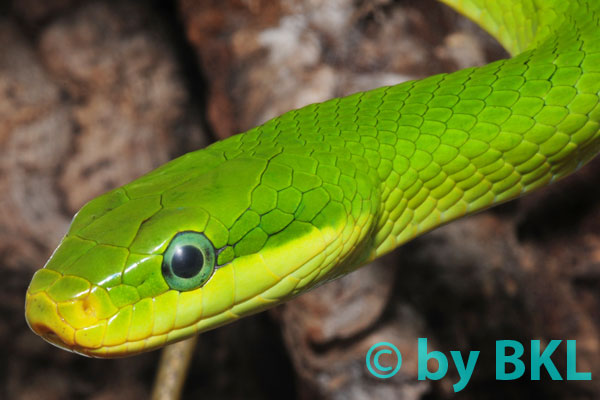
Rhadinophis prasinum: Close-up of a captive-bred female showing the green iris of this species • Die Nahaufnahme dieses Nachzuchtweibchens zeigt die grüne Iris der Art.
© Boris Klusmeyer
© Boris Klusmeyer
Green Trinket Snake / Green Bush Rat Snake
Description
Non-venomous. Named afte the Latin word prasinus = leek green, which refers to the yellow-green colour of the species. From North Vietnam some turquoise animals are known also, others show white spots between the scales. Like Rhadinophis frenatum this species was placed into the genus Gonyosoma, it remains to be seen how long the scale counters stick to this opinion. Unlike the brown and striped eyes of Rhadinophis frenatum the iris of this species is completely green.
The species has similar needs as its sister species, but is easier to maintain and bred frequently. In the terrarium, this species is relatively quiet and lives as secretive as possible like in nature. Its small size is particularly pleasing and makes the green bush snake a perfect pet.
Protection
none
Adult Size
20–24 cm when hatching, adult males 80–90 cm, adult females 100–110 cm
Lifespan
about 15 years
Distribution
China, India, Laos, Malaysia, Thailand, Burma, Vietnam
Environment
relatively cold rain forest areas, mostly from 500–2,000 m elevation, pre-dominantly caught on forest edges
Captive Care
Cage size about 80x50x80 cm WDH or more, include climbing branches, cork tubes and plants. Day temperature 22–27 °C, night temperature 17–22 °C, relative humidity 60–80 %, dry and humid retreats. Spray water is accepted as well as a drinking bowl. Unlike Rhadinophis frenatum this species doesn't get the typical skin blisters from too much humidity. A daylight fluorescent light or bulb often is enough heating, use LEDs alternatively. Peat or coconut humus as substrate.
Food
small rodents, feeds on reptiles, too, in nature, females are much better eaters than males, live food is preferred over dead, don't worry about long breaks in food intake, some specimens may stop feeding after spring until next year
Reproduction and Rearing
Only one male in a cage possible, males tend to bite themselves until severe injuries happen. Rear females at least two years before first mating. 2 months cool period of about 13–16 °C initiate mating. Often mating will take place in the cool period or even before already, when you place animals together which were kept apart before. Deposition of 3–11 eggs about 55 days after successful copulation. Incubate at 25–26 °C for about 65–80 days. Some of the male hatchlings don't accept food voluntarily, goad them until they bite into the feeder item, after which they normally swallow.
Non-venomous. Named afte the Latin word prasinus = leek green, which refers to the yellow-green colour of the species. From North Vietnam some turquoise animals are known also, others show white spots between the scales. Like Rhadinophis frenatum this species was placed into the genus Gonyosoma, it remains to be seen how long the scale counters stick to this opinion. Unlike the brown and striped eyes of Rhadinophis frenatum the iris of this species is completely green.
The species has similar needs as its sister species, but is easier to maintain and bred frequently. In the terrarium, this species is relatively quiet and lives as secretive as possible like in nature. Its small size is particularly pleasing and makes the green bush snake a perfect pet.
Protection
none
Adult Size
20–24 cm when hatching, adult males 80–90 cm, adult females 100–110 cm
Lifespan
about 15 years
Distribution
China, India, Laos, Malaysia, Thailand, Burma, Vietnam
Environment
relatively cold rain forest areas, mostly from 500–2,000 m elevation, pre-dominantly caught on forest edges
Captive Care
Cage size about 80x50x80 cm WDH or more, include climbing branches, cork tubes and plants. Day temperature 22–27 °C, night temperature 17–22 °C, relative humidity 60–80 %, dry and humid retreats. Spray water is accepted as well as a drinking bowl. Unlike Rhadinophis frenatum this species doesn't get the typical skin blisters from too much humidity. A daylight fluorescent light or bulb often is enough heating, use LEDs alternatively. Peat or coconut humus as substrate.
Food
small rodents, feeds on reptiles, too, in nature, females are much better eaters than males, live food is preferred over dead, don't worry about long breaks in food intake, some specimens may stop feeding after spring until next year
Reproduction and Rearing
Only one male in a cage possible, males tend to bite themselves until severe injuries happen. Rear females at least two years before first mating. 2 months cool period of about 13–16 °C initiate mating. Often mating will take place in the cool period or even before already, when you place animals together which were kept apart before. Deposition of 3–11 eggs about 55 days after successful copulation. Incubate at 25–26 °C for about 65–80 days. Some of the male hatchlings don't accept food voluntarily, goad them until they bite into the feeder item, after which they normally swallow.
Grüne Strauchnatter
Generelles
Ungiftig. Benannt nach dem lateinischen prasinus = lauchgrün, das sich auf die gelblich-grüne Färbung der Art bezieht. Aus Nordvietnam sind auch türkise Tiere bekannt, andere zeigen weiße Sprenkel zwischen den Schuppen. Wie auch Rhadinophis frenatum wurde die Art 2014 der Gattung Gonyosoma zugeordnet, es bleibt abzuwarten, wie lange sich diese Auffassung bei den Schuppenzählern hält. Im Gegensatz zu den bräunlichen und gestreiften Augen von Rhadinophis frenatum ist die Iris dieser Art komplett grün.
Die Art hat ähnliche Ansprüche wie ihre Schwesterart, ist aber einfacher zu halten und wird häufiger nachgezogen. Im Terrarium ist diese Art relativ ruhig und lebt ähnlich wie in der Natur möglichst versteckt. Besonders angenehm für die Haltung ist die geringe Größe.
Schutzstatus
keiner
Größe
beim Schlupf 20–24 cm, adulte Männchen 80–90 cm, Weibchen 100–110 cm
Lebenserwartung
etwa 15 Jahre
Vorkommen
China, Indien, Laos, Malaysia, Thailand, Burma, Vietnam
Biotop
relativ kühle Regenwaldgebiete meist von 500–2000 m über Meereshöhe, Fundort oft an Waldrändern
Haltung
Terrariengröße etwa 80x50x80 cm BTH oder größer mit Kletterästen, Korkröhren und Bepflanzung. Tagestemperatur 22–27 °C, nachts 17–22 °C, Luftfeuchtigkeit 60–80 %, feuchte und trockene Versteckplätze. Sprühwasser wird genauso angenommen wie ein Trinknapf. Eine Leuchtstoffröhre reicht oft als Heizung. Alternativ LEDs. Rindenmulch, Torf oder Kokoshumus als Bodengrund.
Futter
kleine Nager, frisst in der Natur auch Reptilien, Weibchen fressen deutlich besser als Männchen, Lebendfutter wird bevorzugt genommen, längere Futterpausen sind fast normal, vor allem bei Männchen, manche Exemplare stoppen die Nahrungsaufnahme nach dem Frühjahr bis zum kommenden Jahr
Zucht und Aufzucht
Nur Paarhaltung möglich, Männchen beißen sich bis hin zu schweren Verletzungen. Weibchen mindestens zwei Jahre großziehen vor der ersten Nachzucht. 2 Monate kühlere Phase von November bis Januar bei etwa 13–16 °C als Paarungsauslöser. Oft kommt es bereits in der kühlen Phase oder zuvor zur Kopulation, wenn zuvor getrennte Tiere zusammengesetzt werden. Ablage von 3-11 Eiern etwa 55 Tage nach erfolgreicher Paarung. Inkubation bei 25–26 °C für etwa 65–80 Tage. Manche junge Männchen fressen nicht freiwillig, lassen sich aber zum Zuschnappen reizen und schlucken dann auch.
Ungiftig. Benannt nach dem lateinischen prasinus = lauchgrün, das sich auf die gelblich-grüne Färbung der Art bezieht. Aus Nordvietnam sind auch türkise Tiere bekannt, andere zeigen weiße Sprenkel zwischen den Schuppen. Wie auch Rhadinophis frenatum wurde die Art 2014 der Gattung Gonyosoma zugeordnet, es bleibt abzuwarten, wie lange sich diese Auffassung bei den Schuppenzählern hält. Im Gegensatz zu den bräunlichen und gestreiften Augen von Rhadinophis frenatum ist die Iris dieser Art komplett grün.
Die Art hat ähnliche Ansprüche wie ihre Schwesterart, ist aber einfacher zu halten und wird häufiger nachgezogen. Im Terrarium ist diese Art relativ ruhig und lebt ähnlich wie in der Natur möglichst versteckt. Besonders angenehm für die Haltung ist die geringe Größe.
Schutzstatus
keiner
Größe
beim Schlupf 20–24 cm, adulte Männchen 80–90 cm, Weibchen 100–110 cm
Lebenserwartung
etwa 15 Jahre
Vorkommen
China, Indien, Laos, Malaysia, Thailand, Burma, Vietnam
Biotop
relativ kühle Regenwaldgebiete meist von 500–2000 m über Meereshöhe, Fundort oft an Waldrändern
Haltung
Terrariengröße etwa 80x50x80 cm BTH oder größer mit Kletterästen, Korkröhren und Bepflanzung. Tagestemperatur 22–27 °C, nachts 17–22 °C, Luftfeuchtigkeit 60–80 %, feuchte und trockene Versteckplätze. Sprühwasser wird genauso angenommen wie ein Trinknapf. Eine Leuchtstoffröhre reicht oft als Heizung. Alternativ LEDs. Rindenmulch, Torf oder Kokoshumus als Bodengrund.
Futter
kleine Nager, frisst in der Natur auch Reptilien, Weibchen fressen deutlich besser als Männchen, Lebendfutter wird bevorzugt genommen, längere Futterpausen sind fast normal, vor allem bei Männchen, manche Exemplare stoppen die Nahrungsaufnahme nach dem Frühjahr bis zum kommenden Jahr
Zucht und Aufzucht
Nur Paarhaltung möglich, Männchen beißen sich bis hin zu schweren Verletzungen. Weibchen mindestens zwei Jahre großziehen vor der ersten Nachzucht. 2 Monate kühlere Phase von November bis Januar bei etwa 13–16 °C als Paarungsauslöser. Oft kommt es bereits in der kühlen Phase oder zuvor zur Kopulation, wenn zuvor getrennte Tiere zusammengesetzt werden. Ablage von 3-11 Eiern etwa 55 Tage nach erfolgreicher Paarung. Inkubation bei 25–26 °C für etwa 65–80 Tage. Manche junge Männchen fressen nicht freiwillig, lassen sich aber zum Zuschnappen reizen und schlucken dann auch.
Literature / Literatur
Grossmann, Wolfgang (2002). Elaphe prasina (BLYTH). Sauria (Suppl.) 24 (3): 573–576. TGB, Berlin.
Gumprecht, Andreas (2006). Kurzmitteilung: Gonyosoma prasinum, Grüne Strauchnatter. Sauria 28 (1): 53. TGB, Berlin.
Schulz, Klaus-Dieter (1991). Die hinterasiatischen Kletternattem der Gattung Elaphe Teil XX Elaphe prasina (BLYTH 1854) und Elaphe frenata (GRAY 1853). Sauria 13 (2): 15-17
Schulz, Klaus-Dieter (1996). A monograph of the colubrid snakes of the genus Elaphe Fitzinger. Koeltz Scientific Books, Königstein im Taunus.
Schulz, Klaus-Dieter (1996). Eine Monographie der Schlangengattung Elaphe Fitzinger. Bushmaster, Berg/CH.
Schulz, Klaus-Dieter & Grossmann, Wolfgang (2000). Pflege und Zucht von Elaphe prasina (BLYTH 1854). Sauria 22 (2): 31–36. TGB, Berlin.
Grossmann, Wolfgang (2002). Elaphe prasina (BLYTH). Sauria (Suppl.) 24 (3): 573–576. TGB, Berlin.
Gumprecht, Andreas (2006). Kurzmitteilung: Gonyosoma prasinum, Grüne Strauchnatter. Sauria 28 (1): 53. TGB, Berlin.
Schulz, Klaus-Dieter (1991). Die hinterasiatischen Kletternattem der Gattung Elaphe Teil XX Elaphe prasina (BLYTH 1854) und Elaphe frenata (GRAY 1853). Sauria 13 (2): 15-17
Schulz, Klaus-Dieter (1996). A monograph of the colubrid snakes of the genus Elaphe Fitzinger. Koeltz Scientific Books, Königstein im Taunus.
Schulz, Klaus-Dieter (1996). Eine Monographie der Schlangengattung Elaphe Fitzinger. Bushmaster, Berg/CH.
Schulz, Klaus-Dieter & Grossmann, Wolfgang (2000). Pflege und Zucht von Elaphe prasina (BLYTH 1854). Sauria 22 (2): 31–36. TGB, Berlin.
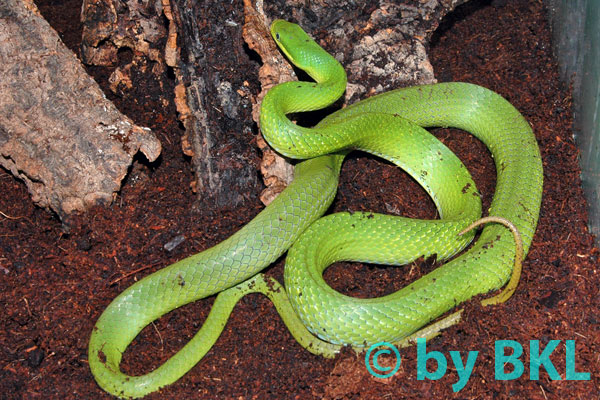
Rhadinophis prasinum: Gravid female • Trächtiges Weibchen
© Boris Klusmeyer
© Boris Klusmeyer
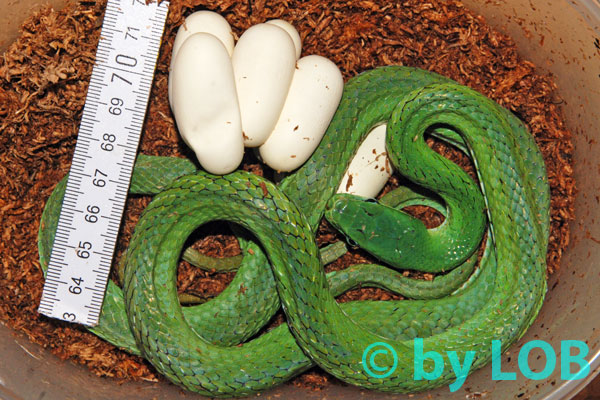
Rhadinophis prasinum: Eggs weigh about seven grams each and have a size of about 28–42x16–18 mm • Das Stückgewicht der Eier liegt bei etwa sieben Gramm bei einer Größe von etwa 28–42x16–18 mm.
© Lutz Obelgönner
© Lutz Obelgönner
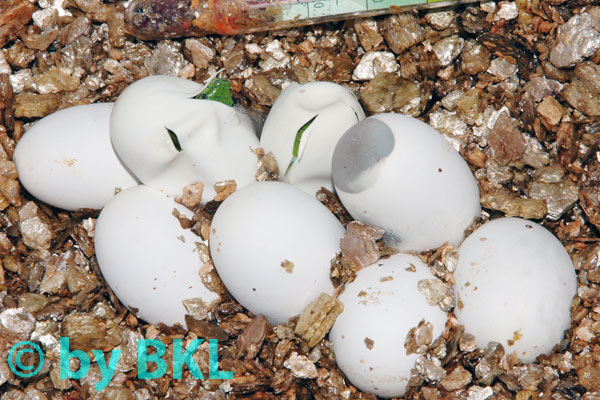
Rhadinophis prasinum: Hatching occurs after 65–80 days incubation time at 25–27 °C • Der Schlupf erfolgt nach 65–80 Tagen Inkubation bei 25–27 °C.
© Boris Klusmeyer
© Boris Klusmeyer
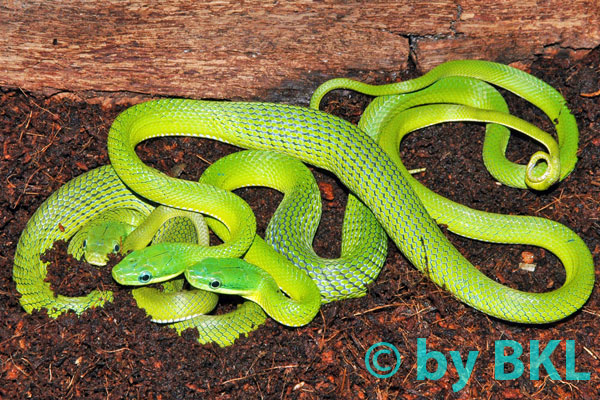
Rhadinophis prasinum: Hatchlings normally are good eaters and grow rapidly to sexual maturity even though some males feed reluctantly • Schlüpflinge gehen normalerweise gut ans Futter und erreichen die Geschlechtsreife schon nach zwei Jahren, aber einige Männchen fressen nur widerwillig.
© Boris Klusmeyer
© Boris Klusmeyer